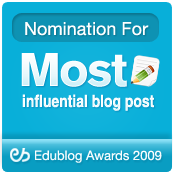I love how you have placed the responsibility for learning so clearly on your students. A common concern about using digital tools for classwork and assessments is that the students will be "cheating". This lesson demonstrates how the social tools facilitate every student's learning - and demands each student to contribute.
I would say that social media actually may present us with a new post-cheating paradigm. I liken it to students in an oil painting class: barring having someone else do it for you, you just "can't" cheat on an oil painting.
Because of the transparency of Web 2.0, cheating in the traditional forms -- plagiarism, copying, cribnotes -- is severely limited in a practical sense. Because of the individuality and personalization of assessment and creation via Web 2.0, cheating itself becomes a rather uninteresting option.
Students tend to cheat out of a mix of boredom and procrastination; cheating is a manifestation of a lack of motivation to be authentic -- whether we're talking about the total slacker who cut-and-pastes from Encarta, or the 'sophisticated' cheater who tries to juke the SAT.
Unauthentic assessment will produce cheaters.
And what is unauthentic assessment? I'd define it as assessment that fails in its structural makeup to address the realities of society -- both at a local and global level.
Now, I'm no spring chicken. I know there are kids who will try to cheat their way around anything. I've caught a few in my own classes. But, if the teacher is using the tools available to engage the students rather than just to talk 'at' them, the teacher has got a much better shot of fostering the type of community in the classroom where cheating will not be tolerated among the students themselves. Web 2.0, by its very nature is a medium that requires you to give of yourself to get anything in return. And that's the sort of thing that a good teacher can tap into both to encourage authentic engagement as well as to foster a spirit of classroom-wide local goodwill. Combined, cheating becomes a much less cool option.








Exactly! And makes me wonder why there is pushback here. Many have trouble seeing the learning in authentic or inquiry activities. They are used to memorizing, worksheets, and knowledge dump after the test. Web 2.0 should not change the medium of the original assignment, it should transform the method. Innovation is tough for others to understand. If I design an activity where they can cut and past information, then I have asked them the wrong question.
ReplyDeleteI graduated with a degree in Secondary Social Studies in 2008 and I cannot remember one time in my training that I heard the term "authentic assessment". I was taught alternative ways to assess students, but I did not hear it phrased this way until I started my Middle School certification at Marian College in Indianapolis, IN. We have been talking about this very topic in class and you are right- it IS less interesting to cheat when the forms of assessment are truly engaging. I recently taught a lesson to fifth graders using a website called The Renaissance Connection. If the students had e-mail addresses, it would have been great to just e-mail the questions to them. Even though students had questions in paper form, there was no way to cheat. The main concept I wanted students to grasp was how the Renaissance influenced our lives today. That answer could only be given after researching the site- they were busy the entire class period!
ReplyDelete